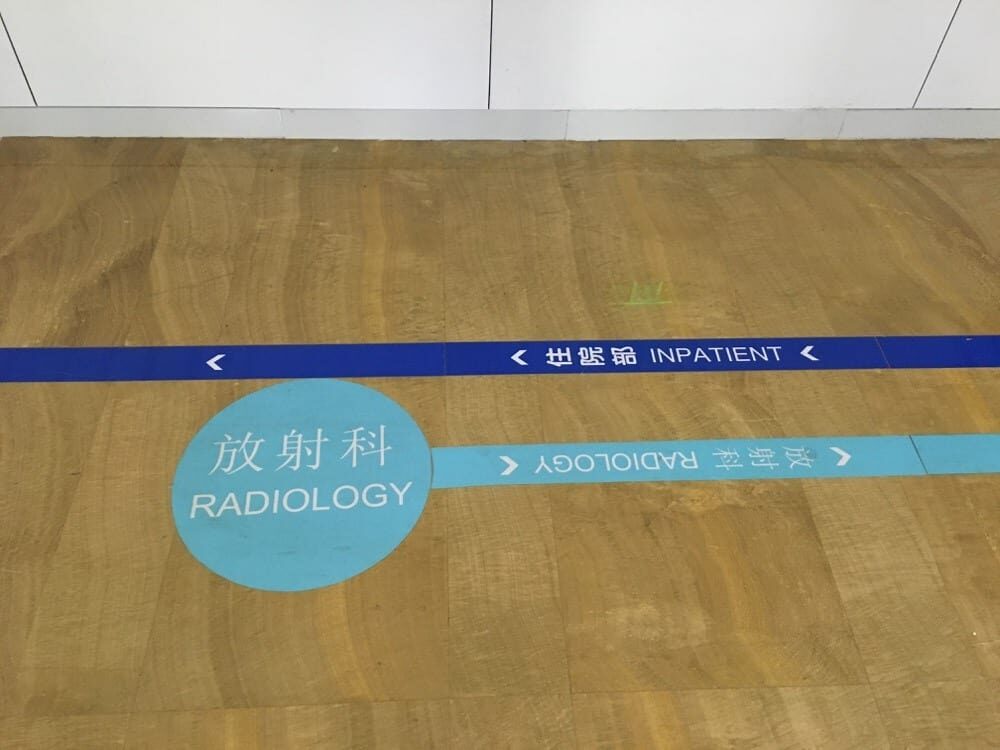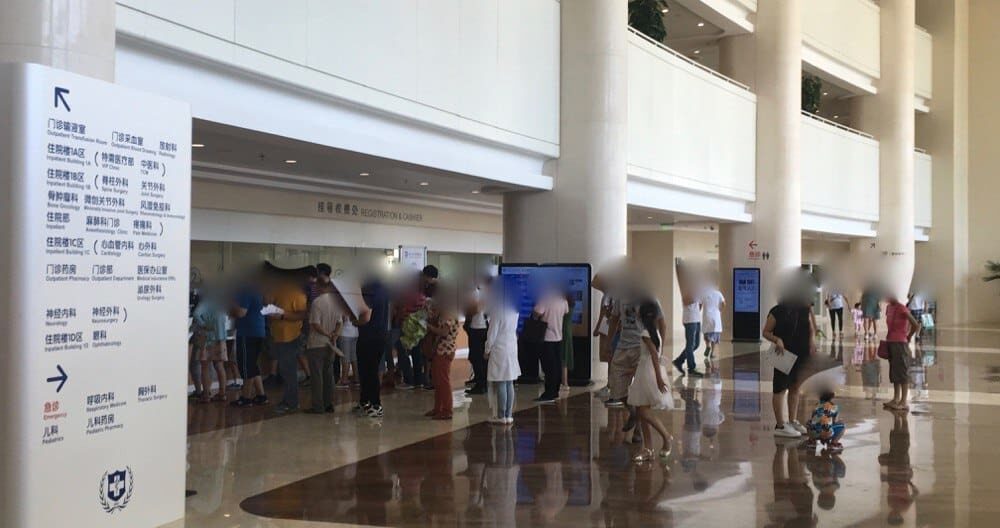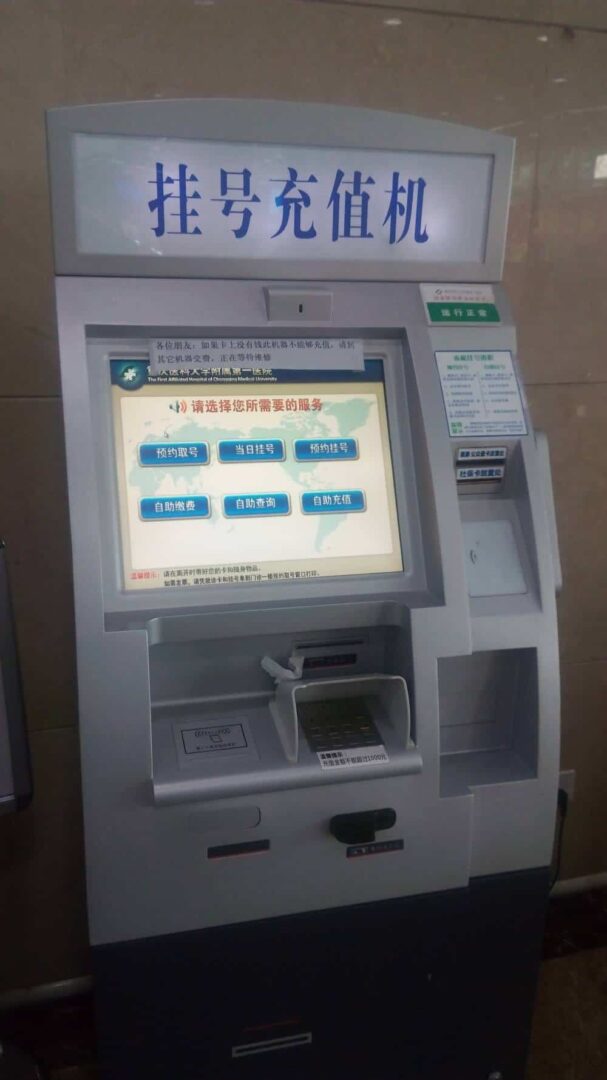Continuing to go through my notes, picking up from my last post…
Visuals
The presenter said something that's certainly a familiar challenge with facilities here in the U.S.:
‘”Patients often get lost due to a lack of good signs.”
One hospital we saw later in the week had some visuals on the ground that were clearly intended as a countermeasure to this problem (and I've seen similar floor markings in some American hospitals):

Somebody in our group said, “Oh, look… visual management.”
It may be semantics, but I'd call that “a visual.”
The term “visual management” refers to the more active management of a process (is there an abnormal condition?)
Not every sign is “visual management” (see this blog post for more, if you wish).
There's no “management” to be done in this system since we probably can't tell visually if a patient is walking in the wrong direction (it's not like radiology patients are wearing light blue clothes).
Hear Mark read this post — subscribe to Lean Blog Audio
Payment & Patient Satisfaction
The presenter also said:
“One reason for conflict between patients and the hospital is that we're always asking them to pay. They might have successful surgery, but one sentence about needing to pay immediately can kill patient satisfaction. Maybe we should focus on money less?”
Always prominent in hospital lobbies were cashier windows and kiosks. I heard many people describe how patients are asked to pay at multiple points during their patient journey, often within a single day (pay for pharmacy, pay for lab testing, pay for the doctor).
Here's one such cashier window (and queue):

Here's a kiosk that could be used for payments and (I believe) scheduling, although people can schedule appointments through WeChat or a phone call too. This hospital said about 75% of patients just showed up without scheduling an appointment (so they wait).

Of course, payment is necessary. It's not strictly a “value-adding” step for the patient, but it's required for the hospital to keep running. I guess it's good to question and challenge how and when the payment is requested.
Lean Design & Detail
The presenter also talked about hospital layout and how “some hospitals are better designed for flow,” such as having the operating rooms and ICU on the same floor or having labs and blood draw stations on the same floor.
She used an example of patients at one hospital having to hold and carry containers with their own specimens, which can lead to spills and mishaps. Another hospital with a better design has “convenient drop-off windows next to the bathroom.”
As I mentioned in the last post, she said, “Some hospitals are paying more attention to details,” which is definitely something you see with “3P” or “Lean Design” initiatives in other countries (see more blog posts about this).
Physicians and Respect
I found it interesting that nobody in the conferences or the hospitals was wearing a necktie. I'm fine with that, and I've questioned (see this blog post) if doctors and administrators are often overdressed here in the U.S.
The British NHS banned long ties ten years ago (although I'm curious if that's actually reduced infection rates, as hypothesized). It did lead to complaints of “scruffy doctors” by 2013.
The Chinese presenter asked if doctors need to dress more formally? She asked if “suits and ties would bring more respect?” and if we'd “show more respect by dressing up?”
Personally, I don't care if my doctor is in a tie or in neat “business casual” attire (or in clean-looking scrubs). Different patients will have different views, of course.
I think respect can be demonstrated in many ways, and clothing might just be superficial.
Again, it's very interesting that this debate is similar, even if the Chinese presenter was thinking about moving from the other end of the attire spectrum, where doctors sometimes show bare legs under their white coat and “it's not decent,” as she said.
The presenter said that healthcare needs to be “warm” in our interactions and that “doctors have no time to talk with patients because they're too busy.”
Solving that problem, releasing time to care for doctors or nurses, requires Lean methods that go far beyond questioning what we wear.
Management Challenges
Another very familiar challenge was brought up (and hospital “director” basically means President or CEO from an American perspective):
“Many hospital directors (CEOs) are not professional managers. They are promoted from their skills. Some hospital directors don't know management OR medical realms… they are the worst. In the middle is the type of director who knows one of the two. The best directors have management AND professional knowledge.”
Again, that seems like a universal challenge. It's great to see more hospitals teaching “Lean leadership” mindsets and skills to supervisors, managers, directors, VPs, and executives. But, sometimes, there's a real need for “remedial” management and supervisor skills training. Leaders in healthcare often don't want to admit they need that help. It's not their fault that they were, too often, never taught how to manage… some people figure this out on their own, but many don't.
More posts will follow on the remaining days of my trip and the hospital visits. Thanks for reading!
Please scroll down (or click) to post a comment. Connect with me on LinkedIn.
Let’s work together to build a culture of continuous improvement and psychological safety. If you're a leader looking to create lasting change—not just projects—I help organizations:
- Engage people at all levels in sustainable improvement
- Shift from fear of mistakes to learning from them
- Apply Lean thinking in practical, people-centered ways
Interested in coaching or a keynote talk? Let’s start a conversation.










![When Was the Last Time a Leader Around You Admitted They Were Wrong? [Poll]](https://www.leanblog.org/wp-content/uploads/2025/07/Lean-Blog-Post-Cover-Image-2025-07-01T212509.843-100x75.jpg)
Agree on the lack of professional managers in Chinese healthcare as a serious concern. While it’s important for healthcare leaders to have an understanding of the patient experience, tertiary level hospitals in China still have CEOs who still operate and see patients. The management can suffer as can the level of patient care that a CEO can personally deliver.